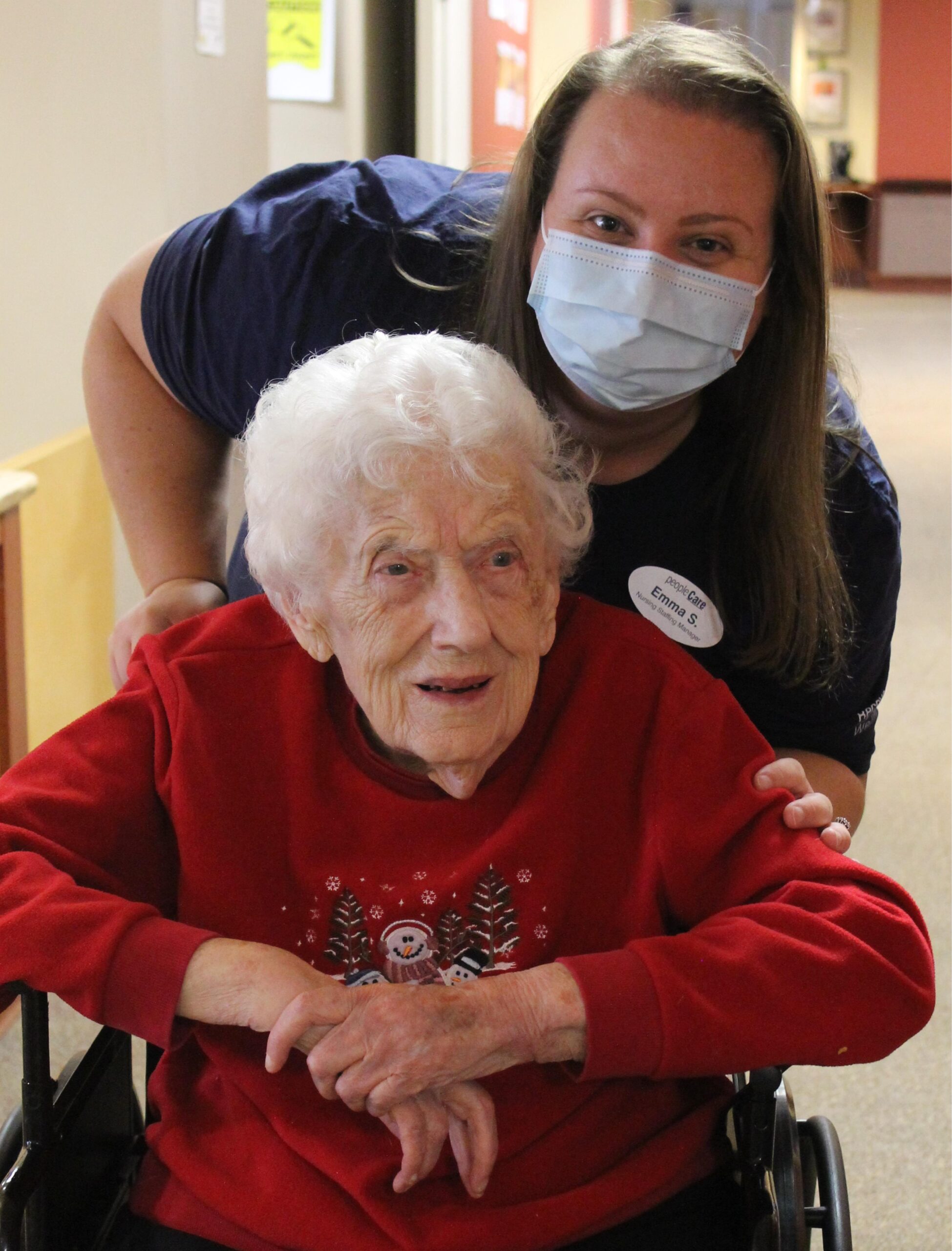Recovering Strong: Supporting employee wellbeing
Ask most health care workers why they do what they do, and you’ll notice a heartfelt recurring theme. Called to care for others. Make a difference. Fulfilled from having made someone else’s life better.
For people whose natural inclination is to care for others, a real challenge of COVID-19 is that it made caregiving more complicated and stressful, leaving many health care workers feeling that no matter how hard they tried at home or work, in a pandemic they could never do enough.
This impact is the motivation behind peopleCare’s Recovering Strong Employee Wellness Strategy, which aims to give the organization’s dedicated team members opportunities to focus on their own well-being and reconnect to their purpose after two long years of stepping up and putting others first.
Emma Schmolling is a Nursing Staffing Manager at peopleCare AR Goudie Long-Term Care whose experience helps highlight the importance of actively supporting employee recovery and wellness. After sending her own baby to live with relatives, Schmolling worked as a personal support worker (PSW) on the frontlines of a challenging outbreak in early April 2020. At one point, she became ill with COVID herself, adding to the strain and grief over the loss of beloved residents.
“peopleCare has always been a special place to work, and I normally felt great knowing my residents received the care they deserve, with a smile,” says Schmolling. “That’s what’s been so hard about COVID. Fear our residents would become ill and more fear when they did. Working in all this personal protective equipment (PPE) that meant my residents couldn’t even see my face. Waiting to cry until the drive home so I wouldn’t bring my team down. All of it impacted my “why” – the reasons I loved going to work.”

peopleCare AR Goudie resident and team member Emma
Wellness, together
peopleCare worked hard to support staff to navigate the unique challenges of this prolonged pandemic, informed by ongoing feedback from the frontline about what they needed, for example around infection prevention training and PPE. As time passed, we recognized an opportunity to acknowledge the impact of COVID on physical and mental health as well, by inviting employees to share their experience and taking action based on what we heard.
That led to “Recovering Strong,” a new strategy aligned with peopleCare’s values that aims to enable employee recovery and wellness. Since everyone’s experience and viewpoint is unique, as a first step we surveyed employees about how they were feeling, giving everyone a chance to share and ask for what they need. We also asked about their wellness priorities and ideas that we could build on in the short and medium term.
Close to 400 staff responded – almost 40% of peopleCare’s workforce, including about 320 frontline staff. The answers gave us valuable information about where to focus our collective wellness efforts. For example, while most staff said they felt good, OK, or at least hanging in there, 22% said they weren’t doing well. This showed us we were on the right track in spending time and resources on employee recovery and wellness.
Providing ongoing opportunities for employees to focus on their well-being, so they feel a renewed sense of purpose and meaning as we transition forward, peopleCare also hopes to improve satisfaction and engagement, which strengthens both recruitment and retention.
“In our experience, health care workers and other caregivers often overlook or put off their own physical, mental and emotional needs,” says Jenn Killing, peopleCare’s Vice President, Quality, Research and Strategic Partnerships. “We also know happy, well staff create positive resident experiences and so we absolutely want to foster a culture that supports our workforce to feel stronger, healthier and more resilient at work and at home.”
Put another way, as one staff member expressed, “If you are well, you can care for others in a meaningful way.”

peopleCare Tavistock team member
Creating connections
For weeks after the survey closed, peopleCare engaged with staff across the organization to share the results and talk about how to work toward recovery and create a culture of wellness and connection.
Based on these conversations and the survey results – for example, that staff wanted to reconnect with others and spend time outdoors – peopleCare organized a virtual Walk to Wellness as the kickoff event of Recovering Strong. It was our way of saying it’s time to get on a path together of having more fun, more joy and more focus on personal well-being.
Over 300 employees collectively walked more than 20,000 kilometres over a two-week period. Using an online app that enabled a vibrant shared experience, the camaraderie was inspiring as staff posted their daily activities and cheered each other on. One staff member said it was a glimpse of normality and connection like before COVID. Another said it was the first activity that had brought a sense of fulfilment back to their day. Residents were in on the fun as well, joining in walking challenges with staff.
Building on the energy and momentum created by the survey and the Walk, each peopleCare home, and our Leadership Support office, has identified Wellness Champions who are helping to engage other staff and collaboratively plan meaningful supports.

peopleCare team member gets some steps in during the Walk to Wellness
Why wellness is a must-have
peopleCare has also begun working with workplace wellness expert Michelle Johnston to elevate our thinking around an effective and sustainable wellness framework.
Johnston is the founder of WorkingWell, an organization dedicated to creating leading practice employee wellness programs, working with employers such as the College of Physicians and Surgeons of Ontario and Trent University.
Johnston explains that in the last decade or so wellness has grown into a critical business function because it helps all types of organizations better serve their customers. While often seen as a nice-to-have, Johnston says wellness is actually a must-have. “Making room for wellness is going to add to your organization’s productivity and success in the long run,” says Johnston. “Time and again we see that by pausing to take care of ourselves, we feel better, perform better, and interact with others in a better way.”
During the pandemic, few people had access to all of their normal coping mechanisms. Those working in health care keenly felt this loss, coupled with added pressures and having less time to recharge. The result is employees who continue to give their all, despite their tanks running on empty. Johnston says employers can use wellness programs to stave off this heightened sense of burnout, build the interaction and fun back in, and enhance the employee experience.
Schmolling agrees. She believes supporting the frontline as we move into whatever comes next will be critical, which is a key reason she volunteered as one of peopleCare’s Recovering Strong Champions. “The pandemic made people rethink their priorities and realize what’s truly important,” says Schmolling. “Staff want to be heard and supported, to know they matter and to feel what they’ve done is valued and recognized. I’m thrilled that’s what peopleCare is doing and I’m super excited to be part of it.”
Prioritizing Employee Wellness
Tips to help shape an effective employee wellness program
In a 2021 Statistics Canada survey of 18,000 health care workers, a full seven in 10 reported worsening mental health during the COVID-19 pandemic. That’s a pretty urgent call to action for any health care organization to prioritize employee wellness. Some tips to consider:
Doing something is better than doing nothing. Working towards better employee wellness doesn’t have to be overwhelming. The key is to just get started. “When you try something new, you learn, and you’ll notice by participation and engagement what worked, what didn’t and when it’s time to do something different,” says workplace wellness expert Michelle Johnston.
Align with your values. The foundations of peopleCare’s Recovering Strong wellness strategy are built around our value of “People.” Establishing a wellness program around existing values, or even articulating new values around wellness, will help organizations layer a wellness focus onto everything they do and knit wellness into the fabric of their culture.
Check in. Everyone’s experience and needs are different. Gathering information directly from employees is an important first step in developing a wellness strategy that can effectively support them. peopleCare’s Employee Wellness Survey gave our teams the chance to tell us how they were feeling, ask for what they need, and share their wellness priorities.
Make it meaningful. Leadership and employees need to work together to shape meaningful wellness programs. “There can be a disconnect between what an organization wants to do and what the employees want for themselves,” says Johnston. “What looks good in theory has to translate to something practical and worthwhile of the employee’s time.”
Balance learning and fun. A lot of activities miss the opportunity to incorporate positive habit formation. Have the barbecues, have the socials, and also look for ways to build in sustainable learnings that will make a difference over the long haul.
Model it. We all have a role to play in creating an environment that supports well-being. As important as engaging the frontline, Johnston says organizations also need buy-in and participation from leadership: “Employees look to see if their managers are fully on board, kind of like a silent permission slip that tells them it really is OK to join in.”
Set aside space for wellness. Having a strong communication framework, a regular time and method for wellness to get communicated – for instance at weekly wellness huddles – is key. If an emphasis on wellness is not regularly in front of people, they will forget about it until the next event.
–
Article written by Sheena Campbell, Vice President of Communications and Engagement at peopleCare Communities. First published in the Spring-Summer 2022 issue of OLTCA’s magazine, Long Term Care Today, available here.
Printable version of article available here.

